-
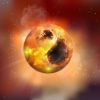 +14 +1
+14 +1One of the brightest stars in our sky has been behaving very unusually. Now scientists think they know why
The recent unusual behaviour of the star Betelgeuse could finally have been explained, after new work by astronomers. The star has been dimming strangely in recent months, with scientists speculating that it could be about to explode into a supernova or was otherwise being subject to an unknown process. Now new research has shown that the most likely explanation of the dimming is large star spots on Betelgeuse's surface, which have caused it to dim.
-
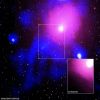 +18 +1
+18 +1Astronomers spot the universe’s biggest known explosion
A black hole about 390 million light-years away has caused the biggest eruption ever seen in the universe. The supermassive black hole sits at the center of a galaxy located in the Ophiuchus galaxy cluster. Its eruption was about five times greater than the last record-holder.
-
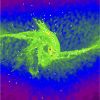 +4 +1
+4 +1Large simulation finds new origin of supermassive black holes
Computer simulations conducted by astrophysicists at Tohoku University in Japan, have revealed a new theory for the origin of supermassive black holes. In this theory, the precursors of supermassive black holes grow by swallowing up not only interstellar gas, but also smaller stars as well. This helps to explain the large number of supermassive black holes observed today.
-
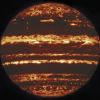 +17 +1
+17 +1Scientists have revealed the clearest ever image of Jupiter
The crystal clear image of Jupiter exists thanks to NASA's Hubble telescope alongside the Juno space probe orbiting the planet, and it is a vision.
-
 +13 +1
+13 +1Hubble finds the best evidence yet for elusive midsized black holes
At about 50,000 times the mass of the Sun, this intermediate-mass black hole skirts the line between shrimp and giant.
-
 +5 +1
+5 +1Very Large Telescope observes exoplanet where it rains iron
Researchers using ESO's Very Large Telescope (VLT) have observed an extreme planet where they suspect it rains iron. The ultra-hot giant exoplanet has a day side where temperatures climb above 2400 degrees Celsius, high enough to vaporise metals. Strong winds carry iron vapour to the cooler night side where it condenses into iron droplets.
-
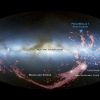 +20 +1
+20 +1Our Galaxy Has Thousands of Alien Stars That Didn't Come from the Milky Way
These aren't Milky Way stars.
-
 +17 +1
+17 +1The 15 most awe-inspiring space images of the decade
We use cookies and other tracking technologies to improve your browsing experience on our site, show personalized content and targeted ads, analyze site traffic, and understand where our audiences come from. To learn more or opt-out, read our Cookie Policy. Please also read our Privacy Notice and Terms of Use, which became effective December 20, 2019.
-
 +4 +1
+4 +1A Cosmic ‘Candy Cane’ Was Spotted at the Heart of the Milky Way
The festive feature is made up of a long stream of high-energy particles where stars may be forming
-
 +4 +1
+4 +1Our Galaxy Recently Exploded with 100K Supernovas, Stunning Images Reveal
New observations from a Chilean telescope showed scientists that the Milky Way's core exploded with massive star deaths just one billion years ago, a recent event in cosmic terms.
-
 +3 +1
+3 +1Black hole nurtures baby stars a million light years away
Black holes are famous for ripping objects apart, including stars. But now, astronomers have uncovered a black hole that may have sparked the births of stars over a mind-boggling distance, and across multiple galaxies.
-
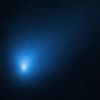 +12 +1
+12 +1Alien comets may be common, object from beyond Solar System suggests
Fresh analysis of 2I/Borisov shows interstellar object is similar to Solar System comets
-
 +14 +1
+14 +1Astronomers discover ghosts of supernovas in nearby galaxy
Researchers from The University of Manchester, with international colleagues, have carried out a survey of a nearby galaxy.
-
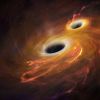 +9 +1
+9 +13 Monster Black Holes Are About to Collide
A rare trio of supermassive black holes has been caught in the act of coming together. Three of the light-gobbling monsters nuzzle shoulder to shoulder in SDSS J084905.51+111447.2, a system of three merging galaxies about 1 billion light-years from Earth, a new study reports.
-
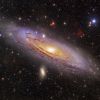 +4 +1
+4 +1The Andromeda Galaxy
The most distant object easily visible to the unaided eye is M31, the great Andromeda Galaxy
-
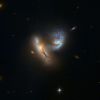 +4 +1
+4 +1Hubble Telescope Spots Two Galaxies in a Doomed (but Dazzling) Dance
The galaxies will ultimately crash into each other.
-
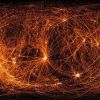 +4 +1
+4 +1Hubble spies a spiral galaxy blooming like roses 70 million light-years away
Around 70 million light-years away, the spiral galaxy NGC 972 appears to be in full bloom.
-
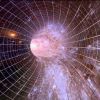 +27 +1
+27 +1This award-winning video reveals the most astounding Hubble images of our universe
Get ready for an epic journey through the cosmos. This film won "Best Short Film" of 2004, and it's no wonder why. The Hubble Space Telescope has revolutionized our perspective on the number of galaxies, stars, and planets in our universe. And you can experience its most astounding images in this award-winning film.
-
 +10 +1
+10 +1Hubble reveals soul-wrenching view of the distant universe
Look at this and you can see 265,000 galaxies reaching back across 13.3 billion years. It took 7,500 exposures from the Hubble Space Telescope to make this mosaic of the distant universe called the Hubble Legacy Field. Take a moment and feel the awe. The Legacy Field follows a succession of Hubble images that have captured more and more previously unseen galaxies. This new view combines observations from several Hubble deep-field surveys taken across 16 years.
-
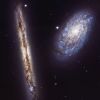 +20 +1
+20 +1Happy birthday, Hubble! To celebrate-a spectacular image of the Southern Crab Nebula
NASA and ESA celebrate the 29th Birthday of the Hubble space telescope on 24th April 2019 with a stunning image of the Southern Crab Nebula.
Submit a link
Start a discussion




















